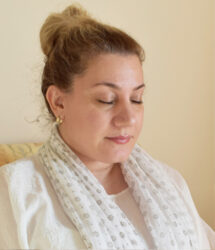Going Beyond “Darkness” and “Light” into the Silence that Nourishes: A Response to Theologian Barbara Brown Taylor

I was struck by the cover of the April 28th Time Magazine: FINDING GOD IN THE DARK. Beyond Enlightenment: Acclaimed preacher Barbara Brown Taylor argues that strength, purpose, and true faith are found in the shadows.
Having just finished my blog post series on the quest for enlightenment, my immediate response was: What is Ms. Taylor getting at? Do we really need more darkness in our already challenging lives? Why would she—a popular theologian in our troubled world—not be interested in light and enlightenment?
As I took a glance, I saw that Ms. Taylor coined a new term, “endarkenment,” and contrasted it with “enlightenment.” Is she just using an edgy new phrase to get us to look further into what she has to say? To some extent, I feel yes…and I am glad I did look further.
Ms.Taylor feels that our culture, and our mainstream spiritual traditions—Christianity being the one with which she is most familiar—are prejudiced towards experiences involving LIGHT, physically and metaphorically. And that we disregard the rich potential growth from experiences of DARKNESS, physically and metaphorically. So what does she mean by “light” and “darkness”?
In her engaging book, Learning to Walk in the Dark, she shares her discoveries relating to “light” and “darkness.” Writing with great candor, sincerity and humor, she describes her spiritual journey as she matures and undergoes losses as well as growth of insights in life. She shares frustrations with her experiences with religion. She states that the words she was using to teach and preach began to feel like “overstuffed pillows.”
Yearning for more, she seeks inner depth of experience—beyond glib words, appearance, and superficial solutions. “Endarkenment” is the phrase she uses for this process of seeking beyond the surface level of life to find depth and balance.
For Ms. Taylor, “darkness” represents what is invisible, hidden, subtle, and silent. “Light” represents that which is visible, apparent, active, expressed. Ms. Taylor eventually finds that spiritual growth should involve a nourishing balance of contrasting experiences—experiences that she points out are often associated with metaphors of darkness and light: rest and activity; silence and expression; patient receptivity and proactive behavior; humility and trust; open-mindedness and certainty.
She also discovers that spiritual growth must go beyond a rigid adherence to particular concepts. In fact, she begins to discover that spiritual awakening must go beyond the field of concepts altogether. Ms. Taylor begins to point to the need for direct experience of profound silence: “unknowingness,” with no object of thought.
This experience of profound silence, beyond mental activity, is what we refer to as “transcendence” from the TM perspective. This very discovery—of direct experience of transcendence and its stabilization in daily life—is what many people, throughout the ages, refer to as “enlightenment.”
Ms. Taylor believes our culture has misconceptions in using the terms light and darkness. However, by coining the term “endarkenment,” and contrasting it with “enlightenment,” she may be contributing to another set of misconceptions. Why use a term that lends itself so easily to misunderstandings? There are other terms that might more adequately describe guidelines for spiritual growth, such as “nourishing” and “life-supporting.”
A CLOSER LOOK at Learning to Walk in the Dark
In her book, chronicling her most recent phase of her spiritual journey, Ms. Taylor shares a range of challenges in her life, including losses. She feels frustrated with the responses from her faith community—what she calls “bumper sticker” faith.
And so she begins an exploration that takes her beyond superficial “light,” consciously delving deeper into experiences of “darkness,” from physical to conceptual to spiritual.
PHYSICAL LEVEL of Light and Darkness: Seeking Rest
Ms. Taylor describes our culture as glutted with stimulation—what she includes under the category of “light.” We have too many hours of physical light, greatly extending normal daylight hours. TV, computers, and an array of electronic devices assault our senses, keeping us from rest, coarsening our senses and fatiguing our minds and bodies.
Ms. Taylor advocates for more rest and silence through more physical darkness, and shares a variety of her experiences.
Flipping off the light switch and computer, Ms. Taylor walks out her door with her dog, relishing experiences as the day darkens, such as the softer light of moonrise. She helps us remember our own childhoods: evening walks or camping trips, our senses gently coming alive in the quietness, catching a scent of honeysuckle in the soft evening air.
By contrast, she laments the decades when she lived in a city where tall buildings and light pollution blocked the sky. Now, living in the countryside, she is quietly awed by the subtle majesty of the Milky Way as it slowly appears in the dark sky.
She finds her senses refining through such subtle experiences. Going to bed earlier, she finds herself refreshed and rejuvenated when she awakens.
I think we all recognize the need for more restful experiences in our lives. We are concerned for the wellbeing of our children and ourselves, increasingly assaulted with too much stimulation, lack of nature, and lack of sleep. Many educators are speaking out against schedules crammed with activities, leaving children almost no time for silence, for times of quiet, to sink into quiet periods where imagination is allowed to unfold.
Research has found that to for creativity to incubate and for knowledge to consolidate in memory, we need regular periods of rest and silence, including enough sleep.
Overstimulation and lack of rest and sleep in our society is leading to an epidemic of exhaustion, anxiety, depression, hyperactivity, and a whole host of disorders—which end up being treated with pharmaceuticals. Many people have found that if we spend more time outdoors in nature, and balance our activity with rest—including enough sleep, as well as the profound rest that TM provides—many of these ills would naturally disappear.
CONCEPTUAL LEVEL of Light and Darkness: Seeking Depth
Ms. Taylor speaks of the superficiality in her experiences within her religious communities. She feels they do not have enough depth in dealing with loss, suffering, and understanding deeper aspects of human potential.
In her experience, they approach life’s problems with answers that are glib or too “light.” They are too willing to accept superficial approaches in dealing with life’s challenges. Instead, she feels people need to be more humble, patient, and open minded, seeking more deeply.
Ms. Taylor recognizes that difficult experiences—such as losses of loved ones or illness or economic challenges—hold potential for growth. Difficulties may give greater impetus to seek beyond superficial solutions to deeper sources of spiritual nourishment.
I have some concern, however, that an over-emphasis on this perspective might lead some people to seek out suffering in the pursuit of growth. Ms. Taylor’s perspective may unintentionally support an OVER-TOLERANCE of painful experiences, such as depression, especially among our youth.
A highly significant perspective that Maharishi brought out regarding suffering is that it is important to do all we can to avoid unnecessary suffering—for ourselves, for our children.
What concerns me regarding using the terms “darkness” and “endarkenment” is that it may, for example,support our societal trend to require children to simply “buck up” and tolerate difficult problems, such as high levels of anxiety and depression. Ms. Taylor’s term of “endarkenment” could be easily misconstrued, adding support to this trend.
I relate more to an idea Ms. Taylor herself comes to in her explorations: to seek experiences that nourish. And I would also suggest a related term that Maharishi used as a guideline for growth: to embrace that which is life-supporting. These guidelines take into account what Ms. Taylor discovers in her journey: that in order to grow and flourish, we need to experience BOTH ends of the spectrum: darkness and light, representing rest and activity, silence and expression.
GOING BEYOND CONCEPT TO INNER SILENCE
A final consideration of Ms. Taylor’s book is her discovery that we must let go of our concepts of sacred reality, realizing that no concept can capture the Divine. She refers to Harvard theologian Harvey Cox, summarizing his perspective: “Doctrines and creeds are no longer enough to keep faith alive. Instead the faithful seek practical guidance and direct experience of the sacred.”
Ms. Taylor also refers to the writings of medieval mystics: John of the Cross, Meister Eckhart, and the anonymous writer of The Cloud of Unknowing. These writers use various metaphors in describing spiritual experiences that she feels are related to her process of “endarkenmnet:” “unknowingness,” “the dark night of the soul,” “holy ignorance,” “the cloud of unknowing.”
Ms. Taylor’s use of these terms is not always clear to me. Sometimes she uses them in relating the mystic’s direct experience of inner silence, beyond words, concept, or any and all mental activity. Her phrase, “the clearing beyond words,” aptly captures that expansive silence.
At other times it seems she uses some of these phrases to refer to a mental exercise of conscious suspension of judgment. And sometimes she relates these terms to experiences of uncertainty or confusion, such as her own “cloudy evening of the soul.”
It is my understanding, and that of other scholars, that these mystics are not talking about consciously suspending our judgments and preconceived ideas about life. Instead, they are describing a direct experience of silence that goes beyond mental activity.
John of the Cross does refer to periods of spiritual dryness, and times of purification in one’s spiritual journey. However, scholar Evelyn Toft explains that the ultimate way he uses the metaphor of darkness is in referring to a direct experience of sacred reality that is “pure and simple, unlimited and unattached to any particular knowledge, and unmodified by the boundaries of form, species, and image.” John of the Cross uses the metaphor of entering “the quiet house” in the “dark of night.” Referring to John’s commentary, Toft explains, “The quiet house is the stillness of the mind and body that no longer entertains any thought, image, or feeling.”
The anonymous author of The Cloud of Unknowing and The Book of Privy Counseling clearly explains his/her experience of the “cloud of unknowing:” an experience beyond the faculty of reasoning: an experience of “perfect stillness.” It is the most attractive of experiences, the author says, because it is saturated with joy and love.
Pointing in the same direction as these mystics, Ms. Taylor recognizes our cultural need to move beyond the level of appearance—what she initially symbolized with the metaphor of “light.” Like the mystics, she urges us to turn down the noise, the activity, the overstimulation. “Be still and know I AM God.” Be quiet enough to hear the still small voice of the Divine.
In my experience, Transcendental Meditation is a way to move beyond concepts, reflections, ideas, words. Not into cloudy confusion, but rather into quieter levels of the mind, pure inner awareness. This is what we refer to as “transcendence” or Transcendental Consciousness, the fourth state of consciousness which is unique from waking, dreaming, and sleep states of consciousness, on all levels, physically and mentally. In this state, consciousness becomes clear, expanded, deeply silent.
From within those silent depths, we find inner light and fullness—bliss. This is the “light” that nourishes life—not with appearance, not through ideas, but through rejuvenating, nourishing silence.
In the course of her journey, Ms. Taylor herself comes to recognize the quiet, hidden light that is within each of us. She quotes Jacques Lusseryan who discovered after becoming blind: “The light dwells where life also dwells: within ourselves.” We appreciate Ms. Taylor’s urging that we must look within, rather than to superficial sources, for our spiritual nourishment.
References
Time Magazine, “Barbara Brown Taylor Faces the Darkness” by Elizabeth Dias: http://time.com/66260/barbara-brown-taylor-new-book-faces-the-darkness/
Barbara Brown Taylor, Learning to Walk in the Dark, Harper Collins, 2014
Harvey Cox, The Future of Faith, as quoted in Barbara Brown Taylor, Learning to Walk in the Dark, p 142.
Evelyn Toft, “Transcendental Speech and Poetic Expression in John of the Cross” https://www.mum.edu/pdf_msvs/v10/toft.pdf, pp 64-65.
The Cloud of Unknowing and The Book of Privy Counseling, edited by William Johnston. Image Books, 1973, pp 70-71.
Jacques Lusseryan, And There Was Light, as quoted in Barbara Brown Taylor, Learning to Walk in the Dark, p 104.
About the Author
Cynthia Johnson is a teacher of the Transcendental Meditation program. She holds a Master of Theological Studies from Harvard Divinity School and is a mother, wife and writer. She is a contributor to the book A Symphony of Silence: An Enlightened Vision (1st and 2nd editions) by George Ellis.





